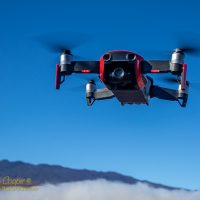OK, so I bought a drone.

Describing the Mavic Air is simple… Impressive.
This is not a review, I am making no effort to list through all of the features and faults of the aircraft. What follows is more my impressions of the drone, a few things I have encountered while learning to use it.
The issue here is that I am completely new to flying a drone, the Mavic Air my first real drone, not considering the cheap $20 toy quadcopter I played with a bit to learn. I have had to learn everything from scratch. It also means I come at this little aircraft with fresh eyes having nothing to compare it with.
This little drone’s capabilities truly are impressive. That is the correct word.
It is clear to this engineer that the Mavic Air is a mature piece of technology. This little aircraft clearly uses the experience DJI has of years in building drones and represents the current state-of-the-art. Nearly every aspect of the aircraft is well thought out.
When shopping for a drone I read and watched quite a few reviews of the Mavic Air. I noted a lot of claims and some lavish praise. The actual machine has lived up to that praise, a very pleasant surprise.
What is there to like?
The camera is surprisingly good. Surprising as the camera is also quite small. Larger than a cell phone camera, but much smaller than the DSLR’s or mirror-less I am accustomed to. This little camera has adjusted my concept of what it takes to obtain good imagery.
I suspect that the small camera will suffer in low light conditions. But as drone operations are restricted to daylight and bright twilight hours, that is probably not much of a concern.
The battery life is quite adequate, I have routinely spent 18-20 minutes in the air, leaving a good margin in the battery for safety. I have on one occasion sent the drone out over a mile, and decided that was probably too far, thus the range exceeds my needs.
The stability of the imagery is incredible, the three axis gimbal works nearly flawlessly. Even when a gusty breeze is bouncing the aircraft around the video remains smooth and stable.
Likewise the panorama modes with built-in stitching work quite well. Both in overcoming the disadvantages of the fixed focal length lens and in allowing unique imagery to be obtained.
Do I have any gripes? Of course.
Why does the drone have to be powered up and linked to be able to practice with the simulator mode on the hand controller and phone?!? I would love to practice flying without the drone on, maybe on an airplane, not expending my few charged batteries for the drone. It seems like an unnecessary restriction.
The camera is very prone to flaring if pointed anywhere near the Sun. If flaring occurs while shooting a panorama it can create very odd artifacts in the stitching. Thus any 360 panorama taken with the Sun low in the sky is likely to suffer issues due to this flaring.
I am very much looking forward to seeing what I can do with this little aircraft. Or more specifically, I look forward to the images I can capture with a camera in the air.


Very impressive especially your pose lol.